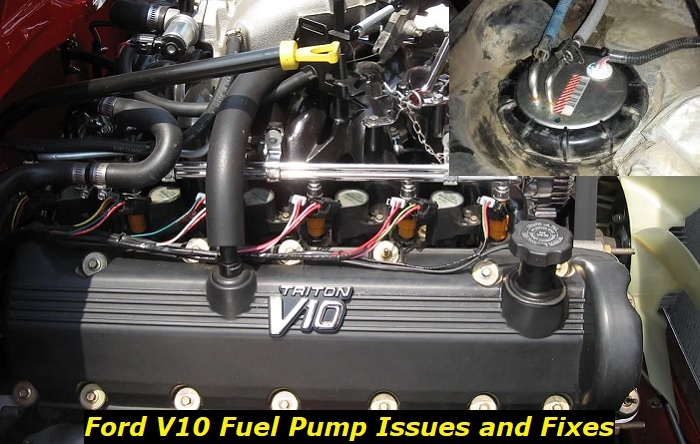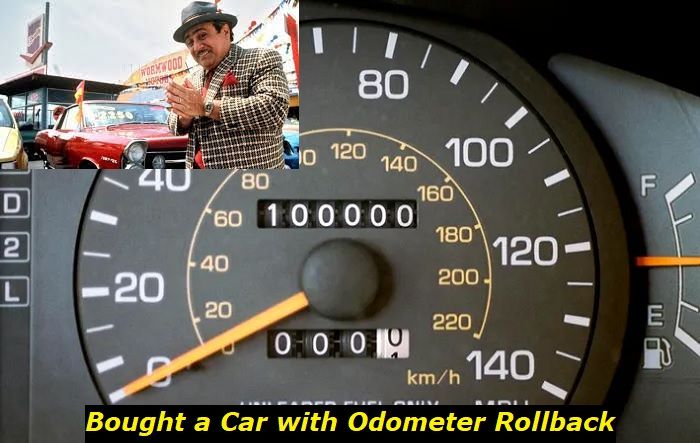The Ford V10 is a high-performance engine that boasts high torque and horsepower. It is known for its reliability and durability. However, after putting some miles on your car, you might notice a decrease in fuel efficiency and power output. These are signs of a problem with the fuel pump.
Key features and my opinion about the engine
- Production years:1997-2019
- Average lifespan of V10 Triton:350,000-500,000 miles
- Fuel supply type:port injection
- Power range:288-362 hp
- Fuel efficiency:awful
- Engine block material:cast-iron
- Engine reliability score:high
- The most common problems:exhaust issues, spark plugs dying too soon, enormous fuel consumption.

Signs of Fuel Pump Problems
The fuel pump is like the heart of the engine, responsible for delivering fuel to the parts that need to make use of it. A faulty fuel pump will not deliver enough fuel to the engine. This can cause a variety of problems that will affect the engine's performance. Some common symptoms of a faulty fuel pump are:
- Reduced fuel efficiency.
- Difficulty starting the engine.
- Engine stalling.
- Sudden loss of power.
- A loud whining noise from the gas tank
If you notice any of these symptoms in your car, then it is important to have your fuel pump checked as soon as possible. Ignoring these issues can result in damage to the engine.
Causes of Fuel Pump Problems
Car fuel pumps can develop a variety of problems, some of which can be difficult to diagnose. Some common issues that fuel pumps can experience include:
- Worn or Faulty Fuel Pump
The fuel pump contains many moving parts and gears that can wear down after many years of use. They can also get damaged by contaminants in the fuel, like solid particles and debris.
The fuel pump can also fail as a result of overheating. This can be caused by driving the car when the fuel level in the tank is too low.
- Becoming clogged or contaminated with dirt or debris
When solid contaminants get through the fuel filter, they can cause clogs in the fuel pump and other parts of the fuel system. A clogged fuel pump won't effectively deliver fuel to the injectors, resulting in sputtering and power loss.
- Developing a Short Circuit or Electrical Failure
A fault in the fuel pump and its wiring can cause the failure of the pump. This will result in intermittent or hard starting.
How to Fix Ford V10 Fuel Pump
A faulty fuel pump will negatively impact the impressive performance of a V10. The engine is built for heavy-duty tasks but will not be able to perform at its peak if the fuel pump is bad. To get the engine running smoothly again, you will need to diagnose the issue and fix it.
To diagnose problems with a car's fuel pump, you can start by checking for any diagnostic trouble codes stored in the vehicle's engine control unit (ECU). These codes can indicate a variety of issues with the fuel system, including problems with the fuel pump.
It's worth noting that a faulty fuel pump will not always return any trouble codes. If this is the case, you can use a fuel pressure gauge to detect the pressure in the fuel system. If it is too low, then you may have a clogged or damaged fuel pump.
- Clean the Clogged Fuel Pump
The most common symptom of a clogged fuel pump is sporadic power loss and sputtering. This is caused by the pump failing to push enough fuel to the injectors. If you notice these symptoms, then you can consider a clogged fuel pump to be the source of your problem.
A clogged pump will only need to be removed and cleaned. If you leave the clogged pump in for too long though, it will eventually need to be replaced as the pump will work harder to push fuel and will eventually burn itself out.
Once you have cleaned the pump, you should also change your fuel filter. A clogged fuel pump is a sign of a bad fuel filter.
- Replace the Faulty Pump
Your fuel pump can break down because of age, or overheating. When this happens, it is best to have the pump removed and replaced. If the pump broke down because of clogging, or damage from fuel debris, then you will need to change the fuel filter as well.
Most Ford V10 vehicles use a submerged fuel pump. This is more difficult to remove than an external pump, as it requires the removal of the fuel tank. As a result, pump replacement is a complex and time-consuming process, so it is best to have a trained mechanic handle it. It is also important to use high-quality replacement parts to ensure that the fuel pump continues to function properly.
- Examine the Pump and Wiring for Electrical Problems
Your fuel pump can fail if there is a problem with the wiring that powers it. The most common symptom of faulty fuel pump wiring is a complete inability to start the car. You might also hear a consistent clicking noise from the pump whenever you try to start the car.
You can examine the fuel pump to figure out if there is an electrical issue within the pump or its associated wiring.
You can remove the fuel pump and test the wiring harness with a multimeter. If there is no current flow, then there is a problem with the wiring. You can examine for damaged or burnt-out wires, or you can have an auto electrician repair the wiring.
While the pump is out, you should test it with the multimeter as well. If the pump does not work, then you will need to replace it.
How to Maintain Your Fuel Pump
Your car's fuel pump is not a part that needs regular or routine maintenance, but some steps can be taken to keep it in good condition. Proper fuel pump maintenance will extend its lifespan and keep your engine running smoothly.
1) Keep a clean fuel filter
The fuel filter prevents dirt and impurities in the fuel from clogging the fuel system components. When a fuel pump gets clogged, it results in reduced power and sputtering. This is because the fuel injectors are not receiving enough fuel. The pump will work harder to try and deliver the fuel, which can cause the pump motor to break down prematurely.
You can prevent this by regularly cleaning your fuel filter. If the fuel filter is excessively dirty or damaged, you should remove it and replace it. Make sure to replace it with a high-quality fuel filter.
2) Keep the Fuel Pump Clean
Keeping your fuel pump clean doesn't require taking the pump out to clean it manually. You can keep your pump clean by regularly using fuel cleaner. It dissolves solid particles that can build up and clog the fuel system. You can get fuel system cleaner at your local auto shop or online.
Once you have your fuel system cleaner, you can follow these instructions to keep your pump clean.
- Make sure the tank is low or nearly empty.
- Read the instructions on the bottle and pour the appropriate amount of fuel cleaner into the fuel tank.
- Fill the tank with fuel. Make sure to fill up the tank as much as possible. This will mix the cleaner with the fuel.
- Idle the engine for ten minutes. This will circulate the cleaner through the system, and it will begin breaking down the solid deposits in the fuel pump.
- You can now drive your car. The cleaner in the fuel will continue to clean your fuel system and fuel pump as you drive.
3) Don't Drive Often on a Low Fuel Tank
Running your car with a low fuel tank is generally bad for your fuel pump and engine. The flow of fuel through the fuel pump helps to cool it down and remove the excess heat it generates. When the level of fuel in the tank is low, there won't be enough fuel flowing through the pump to keep it cool. This causes the pump to overheat.
Running on a low fuel tank a few times won't damage your pump, so it's fine to do so in a pinch. But driving on low fuel too frequently will reduce the lifespan of your pump. It also allows the debris that has settled in the tank to get into the fuel system. This debris can damage the pump or other fuel system components.
It is recommended that you keep the fuel tank above 25% capacity as often as you can.
Conclusion
The Ford V10 engine is a high-performance engine known for its reliability. However, the pump is often victim to breaking, failing, or going bad. If you're experiencing fuel pump problems with your V10, you will need to diagnose the problem and solve it quickly to prevent further damage.
The most common fuel pump problems experienced are a clogged fuel pump, electrical problems, and a worn pump. A clogged pump will need to be cleaned and replaced along with the fuel filter. However, a damaged pump, or a pump with damaged wiring, will need to be replaced to get the car running again.
About the authors
The CarAraC research team is composed of seasoned auto mechanics and automotive industry professionals, including individuals with advanced degrees and certifications in their field. Our team members boast prestigious credentials, reflecting their extensive knowledge and skills. These qualifications include: IMI: Institute of the Motor Industry, ASE-Certified Master Automobile Technicians; Coventry University, Graduate of MA in Automotive Journalism; Politecnico di Torino, Italy, MS Automotive Engineering; Ss. Cyril and Methodius University in Skopje, Mechanical University in Skopje; TOC Automotive College; DHA Suffa University, Department of Mechanical Engineering






Add comment